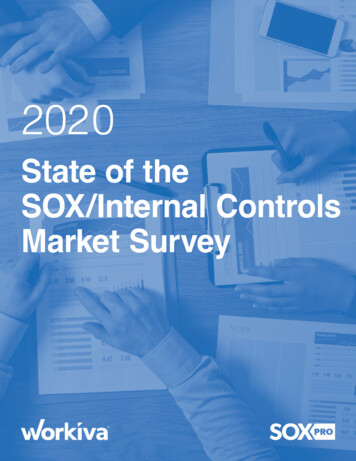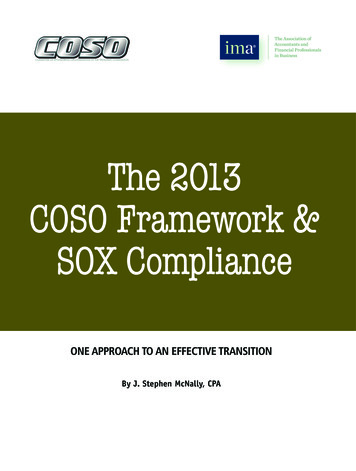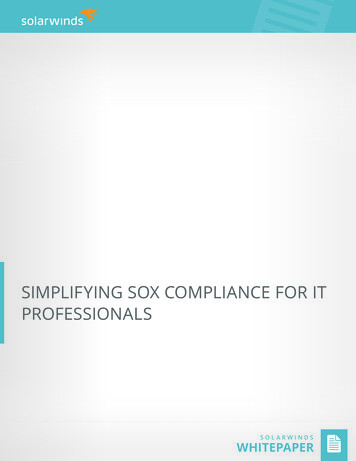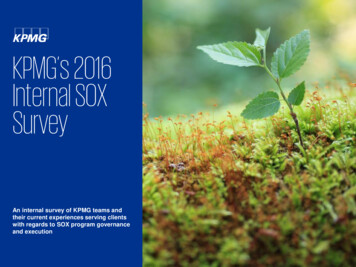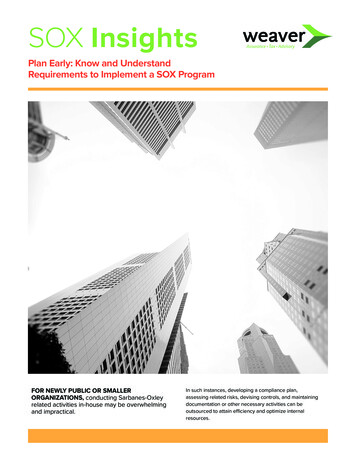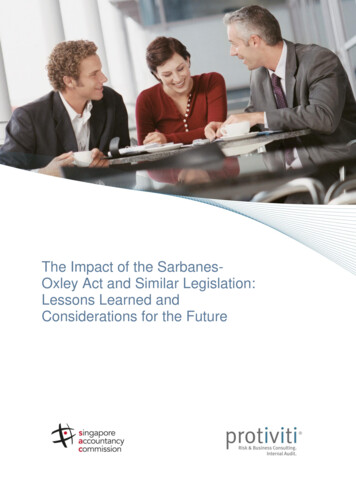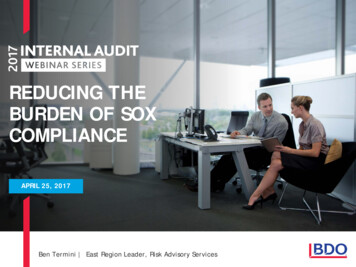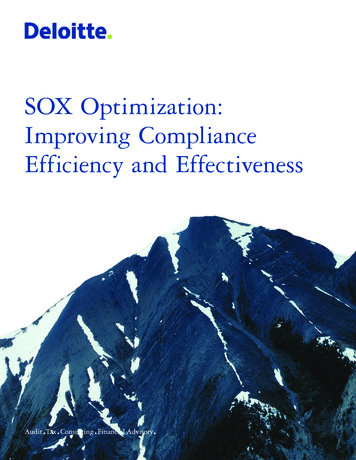
Transcription
SOX Optimization:Improving ComplianceEfficiency and Effectiveness
This publication contains general information only and Deloitte & Touche LLP is not, by means of this publication, rendering accounting,business, financial, investment, legal, tax, or other professional advice or services. This publication is not a substitute for such professionaladvice or services, nor should it be used as a basis for any decision or action that may affect your business. Before making any decisionor taking any action that may affect your business, you should consult a qualified professional advisor. Deloitte & Touche LLP, its affiliatesand related entities shall not be responsible.2
SOX Optimization:Improving ComplianceEfficiency and EffectivenessIn initially implementing the provisions of the Sarbanes-Oxley Act of2002 (SOX), many companies faced serious dilemmas in striking abalance between complying with the regulations, keeping costs down,and attempting to garner benefits around improved internal controls.Many also sought to leverage the requirements to result in a competitiveadvantage and increased shareholder value.Such concerns have been expressed by many participants inrecent Deloitte1 Dbriefs for Financial Executives webcasts and inthe comment letters that registrants sent to the Securities andExchange Commission (SEC) and Public Company AccountingOversight Board (PCAOB) regarding the December 2006 Section404-related proposals.The SEC approved its final management guidance related tointernal control assessments on May 23, 2007. The PCAOBapproved its revised auditing standard for audits of internalcontrol over financial reporting on May 24, 2007; the standardwill be final when approved by the SEC. While the implicationsof the new guidance will vary based on a registrant’s specificcircumstances, generally speaking, companies should benefitfrom the fact that management will have specific guidance itcan apply in its Section 404 processes. Further, the newguidance allows both1management and auditors to focus on the areas of greatest risk.Additionally, the approved guidance includes significant investorsafeguards, will preserve audit quality, and should help makeSection 404 implementation more efficient.For those companies attempting to attain compliance efficienciesand leverage improvement opportunities, a critical element lies inunderstanding the intersection of compliance management withperformance management. Those companies that don’t viewSection 404 as a separate project, but rather embed complianceactivities into ongoing operations, should attain superior results. eloitte refers to one or more of Deloitte Touche Tohmatsu, a Swiss Verein, its member firms, and their respective subsidiaries and affiliates. As a Swiss Verein (associaDtion), neither Deloitte Touche Tohmatsu nor any of its member firms has any liability for each other’s acts or omissions. Each of the member firms is a separate andindependent legal entity operating under the names “Deloitte,” “Deloitte & Touche,” “Deloitte Touche Tohmatsu,” or other related names. Services are provided by themember firms or their subsidiaries or affiliates and not by the Deloitte Touche Tohmatsu Verein. Deloitte & Touche USA LLP is the U.S. member firm of Deloitte ToucheTohmatsu. In the United States, services are provided by the subsidiaries of Deloitte & Touche USA LLP (Deloitte & Touche LLP, Deloitte Consulting LLP, Deloitte FinancialAdvisory Services LLP, Deloitte Tax LLP, and their subsidiaries), and not by Deloitte & Touche USA LLP.
The CFO’s QuandaryThe enactment of SOX placed great pressure on companies ingeneral and CFOs in particular. During the first year, the demandsto meet the basic requirements of the law meant that, rather thanusing SOX as a catalyst for business improvement, manycompanies struggled simply to comply. Out of necessity, someorganizations focused on short-term results (compliance) ratherthan a long-term strategy (driving continuous improvement).Many SOX efforts lacked a consistent, methodical process.Companies had little inkling how to prioritize. This often createdmajor expenses and many headaches.In year two and subsequent years, the issue of cost landed on theCFO’s doorstep. The perception: compliance was too expensive.The mandate: CFOs must cut costs. The quandary: how to reducecosts without jeopardizing compliance.The resultant attempts to address this dilemma often lackedmethodological rigor, and the outcomes were frequentlyunsatisfactory. In an effort to rein in compliance costs, manycompanies were stymied, uncertain whether they could safely cutcontrols, and, if so, unsure which controls to cut and which toretain. Efficiency and effectiveness in internal control over financialreporting was not attained.Top-Down, Risk-Based ApproachA top-down, risk-based approach has been endorsed by thePCAOB and the SEC as a means to attain efficiency and effectiveness of internal control over financial reporting. A key componentof this strategy is the understanding that not all risks, accounts,and transactions are equally important (a theme that we addressin our Risk Intelligent Enterprise series of publications2 ). Alsoimportant are the principles that top-level, company-wide controlscan have a more pervasive impact than lower-level, process-basedcontrols; and that relevance and materiality should be keyconsiderations in control testing plans.How does the top-down, risk-based concept apply in the realworld? Take payroll as an example. Because wages and salariesare typically a large expense item for most organizations, manycompanies have documented all of the controls within the payrollcycle, and are typically doing extensive testing of these controls,including sampling of individual transactions.22While there may be instances where this is an appropriateapproach, for many companies applying a top-down, risk-basedapproach will reveal that payroll is highly routine, systematic, andpredictable, is not subject to management estimates, and thuscarries little risk of financial misstatement. When those “normal”conditions apply, then testing and documentation in this area canpotentially be reduced by placing greater reliance upon management’s periodic monitoring procedures.Why Top Down?Why focus on top-level controls? Because, like mountainsnow feeding valley streams, everything flows from the top.Controls at the company-level can have an encompassinginfluence over controls at the process, transaction, orapplication level. Furthermore, controls that apply to alllocations and business units help to set consistent standardsand expectations across the company.Company-level controls include items such as tone at the top;policies and procedures; codes of conduct; the assignment ofauthority and responsibility; management’s risk assessmentprocess. Also in this category are controls that monitor othercontrols, such as oversight and assessment of the internalaudit function, the audit committee, and employee selfassessment and fraud prevention activities, such as whistleblower hotlines, which can have an indirect relationship tofinancial statement misstatement risk.In addition, many companies have the opportunity tosignificantly increase their reliance upon company-levelcontrols that can directly mitigate financial statementmisstatement risk, including controls over the period-endfinancial reporting process; monitoring controls such asanalytical review and budgeting; and controls governingcentralized processing, such as shared service environments.For more information on The Risk Intelligent Enterprise, visit www.deloitte.com/RiskIntelligence.
Deloitte & Touche LLP’s SOX Optimization ApproachAccording to a February 2007 poll of Deloitte Dbriefs webcastviewers 3, almost 60 percent of surveyed companies plan toconsider or revisit “control rationalization” as a result of the SEC’sproposed guidance. A majority (53 percent) of companies are alsoconsidering changes to their testing strategy and levels ofdocumentation as a result of the SEC’s proposed guidance.Deloitte & Touche LLP (Deloitte & Touche) believes companiesshould adopt a risk-based control rationalization approach as partof a larger effort towards SOX optimization. A key element ofSOX optimization is control rationalization.What, exactly, do we mean by “control rationalization”? Simply,we mean that not all controls are created equal. Some are morestrategically important; some address more significant risks.Because of this inequality, controls should analyzed andprioritized, starting with the highest-level controls used bymanagement to ensure reliable financial reporting . In conductingthis assessment, the internal control and finance teams shouldpose a number of questions: What control objectives areaddressed by these controls? Are they sufficiently detailed toprovide the required level of assurance? What would be theimpact of the failure of these controls? Is there sufficient evidenceof the performance of these controls? By answering these andother questions, the team will be “rationalizing” the existinginternal controls and better “aligning” their internal controlstructure with risk with the goal of retaining only the moststrategic, efficient, and effective.This approach focuses on the continuous process of designing anddeploying only the most effective and efficient controls to addressfinancial reporting risks. Control rationalization applies a topdown, risk-based approach; eliminates unnecessary controls; usesrisk-based testing plans; and optimizes the design ofcompany-level and automated controls.It’s important to note that because control requirements willchange as the business changes, control rationalization shouldbe approached as a multi-year, continuous effort that should beintegrated into the company’s operations. It can bring immediatebenefits, but companies can achieve even more significant costsavings by adopting a long-term strategic approach to sustainedcompliance.Does your company plan to consider or revisitcontrol rationalization as a result of the SEC’sproposed guidance?Votes Received: 2426Don’t knowor N/A32.7%Yes59.4%No7.9%Is your company considering changes to its testingstrategy and levels of documentation as a result ofthe SEC’s proposed guidance?Votes Received: 2420Don’t knowor N/A34.0%Yes53.4%No12.6%3 The Feb. 9, 2007 Dbriefs for Financial Executives webcast was attended by 3453 business executives. The demographic breakdown included 45% manager level; 27% executivelevel; and 24% analyst level. Industries represented included financial services – 25%; technology, media, and telecommunications – 16%; consumer business – 13%; manufacturing – 12%; energy and resources – 9%; and life sciences and healthcare – 7%. Due to the fact that survey participants self selected, and thus do not represent a randomsampling, the survey results are not statistically valid and should not be relied upon. Nonetheless, the data represents the collective thoughts and experiences of business peopleat scores of companies, and the accompanying interpretations are based on the experiences and the views of a number of partners and principals of Deloitte & Touche LLP.3
Leveraging TechnologyEffectively leveraging technology can help optimize a company’sSOX effort in several areas, including the following:1. Greater reliance can be placed upon testing of generalcomputer controls and automated controls. In addition tohelping management reduce its manual testing of routinesystematic controls, increased reliance upon general computercontrols and automated controls can allow management tofocus its testing efforts in areas where changes have occurredor areas where there is greater risk due to non-routineprocessing, complexity, or level of judgment. At the sametime, management can potentially reduce its effort in areaswhere the nature of the process or significant changes havenot occurred.2. Technologies can be leveraged to enhance the efficiency andeffectiveness of management’s testing efforts. This includesthe use of file interrogation and continuous control monitoringtechnologies that can analyze entire populations of transactionsfor potential anomalies. These technologies can also help toaugment management’s anti-fraud programs and controls.3. Technology can also be used to improve effectiveness andefficiency of management’s overall compliance effort, includingthe following key areas: C reating a common repository for all key elements of risk(including operational and strategic risk areas). Providingintegrated, enterprise-wide support for all compliance andrisk management activities. E stablishing a common repository for all controls-related documentation (including relevant policies andprocedures). A llowing for centralized capture of assessment and testingactivities.Many organizations are still primarily reliant upon spreadsheets,Word documents, and, in some cases, manual efforts to supporttheir SOX initiatives. In other cases, companies are using pointsolutions that are solely designed to support SOX complianceand are not integrated with the company’s key financial systems.Such methods are unnecessarily primitive. In the last few years,the sophistication of compliance technology has improveddramatically.In a March 2007 Deloitte Dbriefs for Financial Executives webcast4on compliance management, 49 percent of the surveyed participants said that technology tools are essential for the integrationof compliance and performance. Attendees reported that thebiggest challenge to integrating compliance within core processeslies in three areas:1) organizational resistance or inertia2) lack of sponsor or champion3) need for a compelling business case.How do you view the role of IT in integrating themanagement of performance, risk, and compliance?Votes Received: 845While it may help incertain areas, I do notsee technologyas playingDon’t know/ a critical role4.5%N/A12.0%Technology isessential, and canbe used now toenableintegration ofcompliance andperformance49.3%Technology willbe essential, butit will be severalyears or morebefore itwill be upto the task34.2% P roviding automated support for managementcertifications.4 The March 22, 2007 Dbriefs for Financial Executives webcast was attended by 1213 business executives. The demographic breakdown included 43% manager level,29% executive level, and 24% analyst level. Industries represented included financial services – 27%; technology, media, and telecommunications – 17%; consumerbusiness – 11%; manufacturing – 12%; energy and resources – 8%; and life sciences and healthcare – 9%. Due to the fact that survey participants self selected, andthus do not represent a random sampling, the survey results are not statistically valid and should not be relied upon. Nonetheless, the data represents the collectivethoughts and experiences of business people at scores of companies, and the accompanying interpretations are based on the experiences and the views of a number ofpartners and principals of Deloitte & Touche LLP.4
Four-Phase SOX Optimization ApproachDeloitte & Touche has developed a four-phase approach to helpcompanies optimize their SOX compliance work to achieveefficiency and effectiveness. The first two phases of this riskbased approach are tactical/short term. These phases can help thecompany generate immediate reductions in compliance costs andbuild a foundation for a sustainable internal control program. Thelast two phases go beyond the basic compliance requirement andmay require a greater resource investment. But the payout canyield significant rewards.Deloitte & Touche’s SOX Optimization Approach includes thefollowing goals: Understand the overall design and balance of controls and howthey align with financial reporting risks. Shift focus toward higher risk areas to enhance compliancePhase 3: Leverage Automated Controls and Enabling TechnologyIn this phase, companies replace manual controls with automatedcontrols (which are less prone to error and the potential performance problems associated with people-based controls). Automatedcontrols can decrease costs and are usually easier and cheaper totest than manual controls. They also provide more reliability andcan serve as monitoring controls. Continuous controlsmonitoring technology can be used in a number of businessprocesses such as payroll, general ledger, purchasing cards,and travel and entertainment.Besides cost reduction and assurance regardingcompliance status, what do you see as the greatestpotential long-term benefit to integratingcompliance within core processes?Votes Received: 962quality.Don’tknow/N/A6.2% Achieve cost savings by applying more efficient compliance ef-forts for routine processing-related controls.Stronger ethical culture3.4% Identify how company-level (as opposed to process-level)controls can be improved to drive compliance efficiencies andreduce the organization’s overall compliance risk profile.Phase 1: Apply Top-Down, Risk-Based Scoping Approach UsingSEC/PCAOB GuidanceThis phase begins with a risk assessment to understand thecompany’s financial reporting risks and to identify and possiblyreconsider the design of controls. Through this process,companies can scope appropriate areas into the complianceprogram and develop a process where “in scope” areas receivethe amount of attention commensurate with their level of risk.Phase 2: Rationalize Existing Controls and Redesign Test PlansIn this phase, companies rationalize both process-level and generalcomputer controls; identify opportunities for enhancing controleffectiveness; and consider removing redundant process-levelcontrols from compliance testing. Phase 2 also involves applyinga risk-based approach toward testing, which varies the timing,nature, and extent of testing based on the assessed risk. As aresult, companies can direct their resources toward testingcontrols related to the highest risk areas, while minimizing thetesting of controls in low-risk areas.Improvedfocusoncontrols7.6%All ofthe above52.0%Streamlined andmore efficientprocesses22.8%Better visibilityinto the impactof compliancedriven controlson businessprocessperformance8.0%Phase 4: Standardize and Centralize Processes/GRC IntegrationThe value derived from standardizing and centralizing processesand controls extends beyond compliance into day-to-dayoperational efficiencies. This phase focuses on integratinggovernance, risk, and compliance (GRC) activities in order toreduce costs, drive value, and improve overall risk management.5
The payoff from standardizing and centralizing disparateprocesses and controls can be significant compared to the threeearlier phases, although accomplishing this will be a lengthierprocess. A survey conducted during a March 2007 Deloitte Dbriefsfor Financial Executives webcast validates this claim. Attendeespolled during the webcast identified a number of long-termbenefits derived from integrating compliance within coreprocesses, including streamlined and more efficient processes,improved focus on controls, and stronger ethical culture.Organizations that integrate GRC practices will discover it can bea key driver of shareholder value. However, this initiative requiresstrong leadership from the C-suite and the board. An integratedapproach to GRC can help to improve the overall Risk Intelligenceof an organization and enable the use of risk offensively, asopposed to defensively. This includes more effectively managingthe risks associated with the critical operations or keystrategic initiatives that are long-term value drivers.Action PlansOrganizations need to consider the impact that the SEC’sguidance may have on documentation, testing strategy, anddesign of internal control over financial reporting. Thefollowing are a few steps that can be taken in this direction:1. Revisit risk assessment from a top-down, risk-based perspective.At the account and business process level, increase focus onthe assessment of qualitative risk factors, such as subjectivityto estimates and nature of processing, as opposed to focusingprimarily on quantitative factors, such as size of balance. onsider or revisit control rationalization. Focus on thoseCcontrols that, should they fail, would materially impact thefinancial statements. Look first at company-level controls(especially those that directly relate to financial reporting risks)before focusing on departmental and process-level controls.2. Recognize that your approach can and, in most cases, shouldbe different than that of the auditor. Communicate with yourauditor regularly through the process, but, in general, do notreplicate his or her work. Determine in what areas theauditor can rely on your work, and where the auditor musttest independently.3. Increase the level of ownership within the organization forinternal controls. Implementing a program of control selfassessments can significantly augment and enhance controltesting work, while at the same time reinforcing the need forresponsibility and accountability with the most importantperson in the control structure — the control ownersthemselves. Take some of the responsibility for control testingoff the shoulders of internal audit, and imbed control testingand monitoring into daily operations. Deploy internal auditintelligently to maintain a balance of objectivity and ownership:management should get assurance from process owners; internal audit should provide reassurance in areas of greatest risk.4. Focus on reducing effort. Investigate automated controls, whichare generally more reliable, less costly, and more easily testedthan their manual equivalents. Look for efficiency in controldesign.5. Discuss revised plans and contemplated changes with theexternal audit team to help assess how these changes mayaffect the audit process.Springboard to ImprovementA program of SOX optimization and control rationalization canhelp companies overcome the quandary of how to improvecontrols while simultaneously cutting costs — and do so withoutjeopardizing compliance.Examples abound. In 2006, we authored an article in HarvardBusiness Review that illustrated the tangible benefits realizedby several companies — including Kimberly Clark, PepsiCo, andSunoco — that adopted a SOX optimization program5. Morerecently, we published an article in CRO magazine 6 that discussedthe benefits of improving controls efficiency and quality.Compliance with SOX and other regulatory requirements presentsboth burdens and opportunities. Forward-thinking companies willuse the mandate as a springboard for taking an integrated,enterprise approach to Governance, Risk and Compliance,improving the overall Risk Intelligence of the organization.5Harvard Business Review, “The Unexpected Benefits of Sarbanes-Oxley,” April 2006. For a free copy, visit www.deloitte.com/SOX.6Corporate Responsibility Officer (CRO) magazine, “SOX Benefits,” March 2007: http://www.thecro.com/node/400.6
ResourcesContactsFor more information on Deloitte & Touche’s SOX optimizationapproach, visit www.deloitte.com/soxoptimization or contact yourDeloitte & Touche partner.Tom ConnorsPartner, Audit & Enterprise Risk ServicesNational Leader of SOX Consulting Services, Audit & EnterpriseRisk ServicesDeloitte & Touche LLP 1.212.436.2617tconnors@deloitte.comFor more information on the concept of Risk Intelligence, visitwww.deloitte.com/RiskIntelligence.Stephen WagnerManaging Partner, U.S. Center for Corporate GovernanceInnovation Leader, Audit & Enterprise Risk ServicesDeloitte & Touche LLP 1.617.437.2200swagner@deloitte.com7
Dbriefs for Financial ExecutivesWe invite you to visit www.deloitte.com/us/dbriefs to jointhe Deloitte Dbriefs webcast series. The Financial Executives series helps you stay on top of all the latest issues andstrategies in: orporate GovernanceCDriving Enterprise ValueFinancial ReportingPrivate CompaniesSarbanes-OxleyTransactions & Business EventsDbriefs Webcasts Relating to Compliance andSarbanes-OxleySection 404: What does the New Guidance Mean to You?June 28, 2007Governance, Risk, and Compliance: Evaluating Strategy, Structure,and CostsMay 24, 2007The Next Stage of Section 404: Opportunities for Management toOptimize EffortsApril 26, 2007The Intersection of Compliance Management and PerformanceManagementMarch 22, 2007Extracting Lasting Benefits from Compliance EffortsFebruary 22, 2007Special Edition Webcast Section 404: What do the ProposedChanges Mean to You?February 9, 2007CPE credits are offered to viewers of original live webcasts, but arenot available for viewing archived programs.Archived webcasts are available for 180 days after the livepresentation.8
7
#7230About DeloitteDeloitte refers to one or more of Deloitte Touche Tohmatsu, a Swiss Verein, its member firms, andtheir respective subsidiaries and affiliates. Deloitte Touche Tohmatsu is an organization of memberfirms around the world devoted to excellence in providing professional services and advice, focusedon client service through a global strategy executed locally in nearly 140 countries. With access tothe deep intellectual capital of approximately 150,000 people worldwide, Deloitte delivers servicesin four professional areas — audit, tax, consulting, and financial advisory services — and servesmore than 80 percent of the world’s largest companies, as well as large national enterprises, publicinstitutions, locally important clients, and successful, fast-growing global companies. Services arenot provided by the Deloitte Touche Tohmatsu Verein, and, for regulatory and other reasons, certainmember firms do not provide services in all four professional areas.As a Swiss Verein (association), neither Deloitte Touche Tohmatsu nor any of its member firms hasany liability for each other’s acts or omissions. Each of the member firms is a separate and independent legal entity operating under the names “Deloitte,” “Deloitte & Touche,” “Deloitte ToucheTohmatsu,” or other related names.In the United States, Deloitte & Touche USA LLP is the U.S. member firm of Deloitte Touche Tohmatsu and services are provided by the subsidiaries of Deloitte & Touche USA LLP (Deloitte & Touche LLP,Deloitte Consulting LLP, Deloitte Financial Advisory Services LLP, Deloitte Tax LLP, and their subsidiaries), and not by Deloitte & Touche USA LLP. The subsidiaries of the U.S. member firm are among thenation’s leading professional services firms, providing audit, tax, consulting, and financial advisoryservices through nearly 40,000 people in more than 90 cities. Known as employers of choice forinnovative human resources programs, they are dedicated to helping their clients and their peopleexcel. For more information, please visit the U.S. member firm’s Web site at www.deloitte.comCopyright 2007 Deloitte Development LLC. All rights reserved.Member ofDeloitte Touche Tohmatsu
SOX Optimization: Improving Compliance Efficiency and Effectiveness In initially implementing the provisions of the Sarbanes-Oxley Act of 2002 (SOX), many companies faced serious dilemmas in striking a balance between complying with the regulations, keeping costs down, and attempting to garner benefits around improved internal controls.
